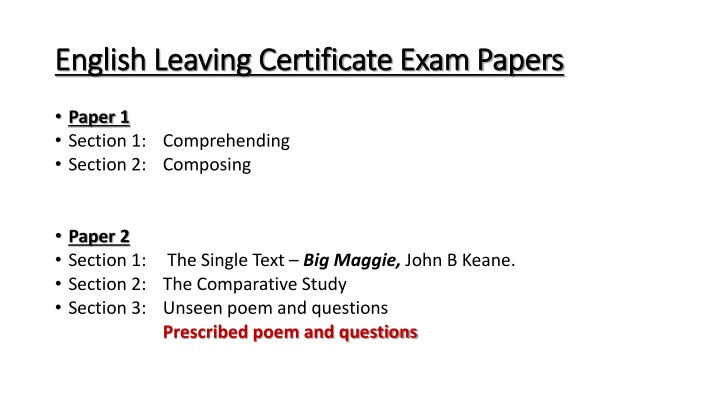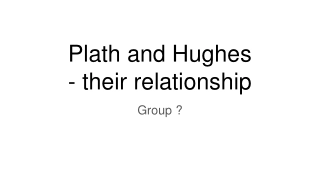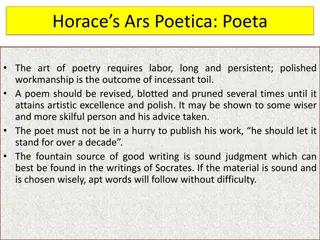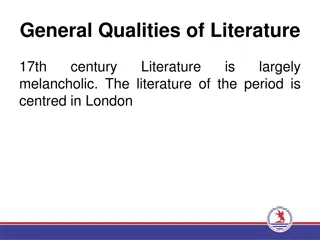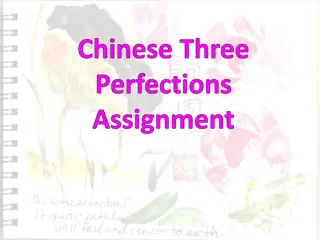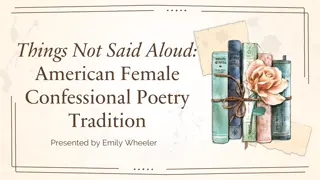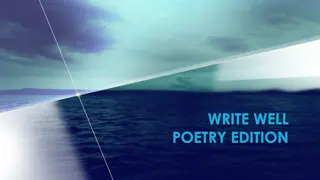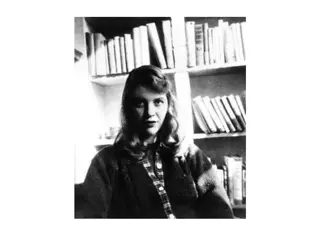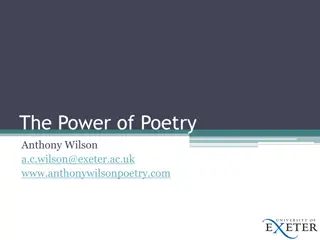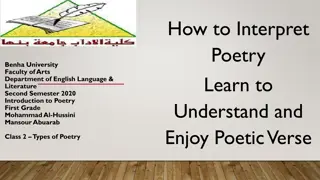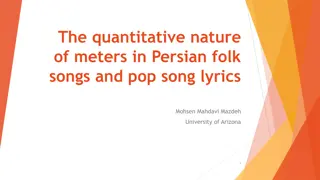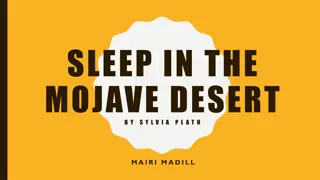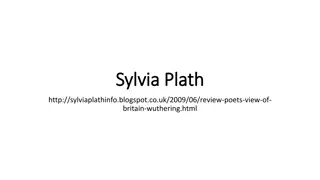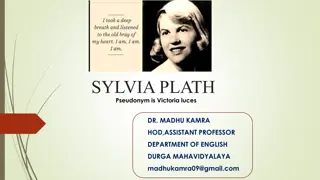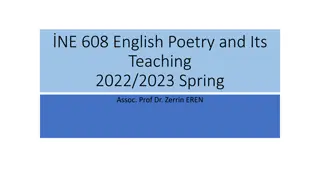The Life and Poetry of Sylvia Plath
Sylvia Plath, a renowned poet, faced significant challenges in her personal life, including the loss of her father at a young age and struggles in her marriage. Despite her talent and successes, she battled with depression and ultimately took her own life at the age of 30. Plath's poems, such as "Child" and "The Arrival of the Bee-Box," reflect her inner turmoil and raw emotions, making her a significant figure in modern poetry.
Download Presentation

Please find below an Image/Link to download the presentation.
The content on the website is provided AS IS for your information and personal use only. It may not be sold, licensed, or shared on other websites without obtaining consent from the author.If you encounter any issues during the download, it is possible that the publisher has removed the file from their server.
You are allowed to download the files provided on this website for personal or commercial use, subject to the condition that they are used lawfully. All files are the property of their respective owners.
The content on the website is provided AS IS for your information and personal use only. It may not be sold, licensed, or shared on other websites without obtaining consent from the author.
E N D
Presentation Transcript
English Leaving Certificate Exam Papers English Leaving Certificate Exam Papers Paper 1 Section 1: Comprehending Section 2: Composing Paper 2 Section 1: Section 2: The Comparative Study Section 3: Unseen poem and questions Prescribed poem and questions The Single Text Big Maggie, John B Keane.
Poetry Poetry
Poet: Sylvia Plath Born Boston 1932 Exceled in school Father died when she was 8 years old Plath experienced a loss of faith as a result of this. In 1941 Sylvia's first poem was printed in the children's section of the Boston Herald. Attended Smith College in 1950 became editor of a magazine. Had both successes and failures in her publications lead to a high-low life in which she often questioned her own talents.
Poet: Sylvia Plath Spent time in a psychiatric hospital (attempted suicide in 1953) 1955 Fulbright scholarship to Cambridge. Meets poet Ted Hughes in Feb. 1956, they marry in June 1956... Two children (Frieda and Nicholas) + cheating husband = rocky marriage!
Poet: Sylvia Plath Plath continued to write powerful poetry however the strain of a failed marriage and the weariness of a lifelong battle with depression simply became too much for Plath. In February of 1963 she took her own life. She was 30 years old.
Sylvia Plath: Poems to cover Child The Arrival of the Bee-Box Poppies in July
CHILD By Sylvia Plath
Child Read the text General class discussion first impressions. Content of poem Language Themes
Pre-reading: Context: This poem was written in 1962 after the birth of Sylvia s second child, Nicholas. Unfortunately the birth of this child coincided with a very painful time for Plath, during which her marriage broke up. Ted, moved to London with his lover, leaving a bitter Plath with two children in Devon.
On top of Plaths own mental anguish [over marriage breakdown] it seems that her depression could also be classed as postpartum. [Symptoms include sadness, fatigue, changes in sleeping and eating patterns, reduced libido, crying episodes, anxiety, and irritability. ]
Postpartum depression may lead mothers to be inconsistent with childcare. Women diagnosed with postpartum depression often focus more on the negative events of childcare. Plath in this poem begins in a positive light in Verse One, however, relapses as the lyrics unfold.
The poem begins with the speaker (Plath) celebrating the beauty of her child s eyes. In the beginning, she is hopeful to fill these eyes with colour and ducks to stimulate her child s imagination [nurturing] Nature/Natural references - Flowers: white, innocent, delicate, youthful without wrinkle . Pool: naturally reflecting positive, exuberant images of the child s fulfilled life. Child by Sylvia Plath The Poem Your clear eye is the one absolutely beautiful thing. I want to fill it with color and ducks, The zoo of the new Whose name you meditate-- April snowdrop, Indian pipe, Little Stalk without wrinkle, Pool in which images Should be grand and classical Verse four sees a shift in mood: colours fade to dark...without a star Not this troublous Wringing of hands, this dark Ceiling without a star. The image of troublous wringing of hands highlights the Plath s frustration and disenchantment with her mother- role
The Title Why is this poem entitled Child ? Entitled Child , it is a poem about a nameless child who has been brought into a dark, uncertain yet beautiful world. However, because of the relationship this child shares with his mother [who is depressed] his existence also becomes dark and colourless. Nameless unattached to her newborn child
Plaths journal entry I felt very proud of Nicholas, and fond. It had taken a night to be sure I liked him... In 2009, aged 47, Nicholas, himself, commited suicide. Did he ever have a chance in life?
Language Child by Sylvia Plath The Poem Your clear eye is the one absolutely beautiful thing. I want to fill it with color and ducks, The zoo of the new Opening stanza uses joyful and optimistic language Whose name you meditate-- April snowdrop, Indian pipe, Little Her poetry is decorated, again, with colour. Colour, for Plath in this poem, represents living, vitality and positivity: colour and ducks . Colourless ( dark ) represents depression. Stalk without wrinkle, Pool in which images Should be grand and classical Not this troublous Wringing of hands, this dark Ceiling without a star.
Language The metaphor of The zoo of the new is so rich with meaning; a world of variety, learning and newness. She uses a playful, childlike language in the life she envisages for her child. Image of the child: April snowdrop, Indian pipe flowers. What do they represent in this poem? Snowdrops are delicate white flowers, here it represents the purity and innocence of the young child. The Indian pipe is also white and delicate looking. But this is also the first hint of darkness in the poem because this flower lives in the darkest part of the forest. It feeds on the decaying matter of other plants. It may represent how Plath felt she was drawing the happiness out of her own child.
Language Alliteration w in stanza three without wrinkle captures the smoothness and clarity of newborn skin and juxtaposes the lone wringing of hands in the final stanza which captures the poet s sense of bewilderment. Assonance [repetition of vowels]: colour and ducks, the zoo of the new . Note the u sound repeated four times here: the ou in colour , the u in ducks , the oo in zoo and the ew of new . This musical touch gestures towards a nursery rhyme effect/ the cooing of a baby.
Language Return of the broad vowel sounds in the final stanza: troublous , dark , without , star Tercets (3 line stanzas) are linked together by a series of run-on lines. This use of enjambment allows Plath to create a soothing, gentle and almost rockabye momentum.
Task: There are 2 very different and distinct sets of emotions in this poem. Draw a column page. Write Positive over in the left-hand column and Negative over in the right. Divide the main words and phrases in this poem into the 2 columns. At the bottom of the page, write down whether the poem left you with positive or negative feelings overall.
Task: Complete Table Child Key Point Quote Explain Theme Mental anguish Not this troublous/Wringing of hands The poet describes her distress and despair by giving us an image of her twisting her hands with upset. She doesn t feel that she can provide what her child needs and this fills her with terrible mental anguish. Tone (Feeling, mood, atmosphere) Feelings of joy and admiration Technique (The way the poet uses language) Metaphor
Complete Exam Question: Complete Exam Question: 2014 Ordinary Level Paper Prescribed Poetry
2014 Ordinary Level Paper Prescribed Poetry (a) What feelings are expressed by the poet in the first three stanzas of this poem? Support your answer with reference to the poem. (10) (P.Q.E X2) (b) What feelings are expressed by the poet in the last stanza of this poem? Support your answer with reference to the poem. (10) (P.Q.E X2) (c) Choose two lines or phrases from the poem that appeal to you and explain your choice. (10) (ELABORATE 2 EXPLANATIONS)
Answer ONE of the following: [Each part carries 20 marks] (i) You have been asked to make a short video to accompany a reading of this poem on YouTube. Describe some of the images, colours, music, sound effects, etc. that you would use as a background to the reading and explain your choices based on your knowledge of the poem. (5 PARAGRAPHS) (ii) Which of the following word or words would you choose to describe the language used by the poet in this poem? (4 PARAGRAPHS) (BRAINSTORM/SPIDER DIAGRAM BEFORE YOU BEGIN) Unusual Descriptive Appealing Support your answer with reference to the poem.
